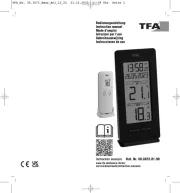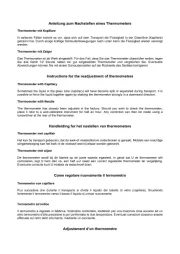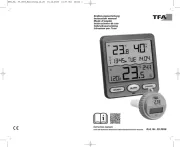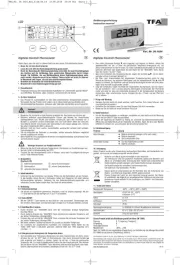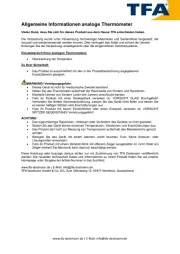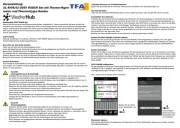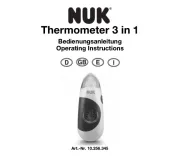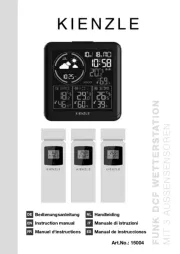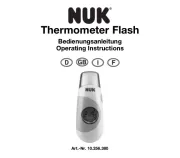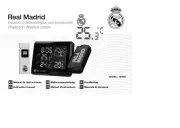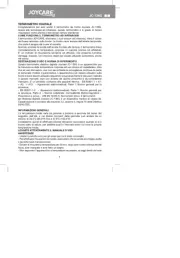
Vielen Dank, dass Sie sich für dieses Gerät aus dem Hause TFA entschieden
1. Bevor Sie mit dem Gerät arbeiten
•Lesen Sie sich bitte die Bedienungsanleitung genau durch.
•Durch die Beachtung der Bedienungsanleitung vermeiden Sie auch
Beschädigungen des Gerätes und die Gefährdung Ihrer gesetzlichen Män-
gelrechte durch Fehlgebrauch. Für Schäden, die aus Nichtbeachtung die-
ser Bedienungsanleitung verursacht werden, übernehmen wir keine Haf-
tung. Ebenso haften wir nicht für inkorrekte Messwerte und Folgen, die
sich aus solchen ergeben können.
•Beachten Sie besonders die Sicherheitshinweise!
•Bewahren Sie diese Bedienungsanleitung gut auf!
• Verwenden Sie das Produkt nicht anders, als in dieser Anleitung beschrieben
• Das eigenmächtige Reparieren, Umbauen oder Verändern des Gerätes ist
• Dieses Gerät ist nicht für medizinische Zwecke bestimmt.
• Vorsicht beim Umgang mit dem spitzen Einstechfühler. Immer mit der
• Halten Sie das Gerät und die Batterie außerhalb der Reichweite von Kindern.
• Kleinteile können von Kindern (unter drei Jahren) verschluckt werden.
• Batterien enthalten gesundheitsschädliche Säuren und können bei Ver-
schlucken lebensgefährlich sein. Wurde eine Batterie verschluckt, kann dies
innerhalb von 2 Stunden zu schweren inneren Verätzungen und zum Tode
führen. Wenn Sie vermuten, eine Batterie könnte verschluckt oder anderwei-
tig in den Körper gelangt sein, nehmen Sie sofort medizinische Hilfe in
• Batterien nicht ins Feuer werfen, kurzschließen, auseinandernehmen oder
aufladen. Explosionsgefahr!
• Um ein Auslaufen der Batterien zu vermeiden, sollten schwache Batterien
möglichst schnell ausgetauscht werden.
• Sollte eine Batterie ausgelaufen sein, vermeiden Sie Kontakt mit Haut, Augen
und Schleimhäuten. Spülen Sie ggf. umgehend die betroffenen Stellen mit
Wasser und suchen Sie einen Arzt auf.
• Setzen Sie das Gerät nicht extremen Temperaturen, Vibrationen und Erschüt-
• Nur der Fühler ist hitzebeständig bis 250°C.
• Halten Sie niemals den Fühler direkt über Feuer.
• Benutzen Sie das Gerät nicht in der Mikrowelle, im Backofen oder Grill.
• Das Gerät entspricht dem Schutzgrad IP 67 und ist gegen Strahlwasser und
zeitweiliges Untertauchen geschützt. Nicht in der Spülmaschine reinigen.
A 4: Symbol „Abschaltautomatik aus”
B 1: ON/OFF Taste Taste B 2: FLIP
B 3: AUTO OFF Schiebeschalter
C 1: C 2:Einstechfühler Batteriefach
C 3: C 4:Display (drehbar um 180°) Schutzhülle
4. Inbetriebnahme und Bedienung
• Nehmen Sie die Schutzhülle von der Einstichsonde.
• Drücken Sie die Taste.ON/OFF
• Das Display zeigt die momentan gemessene Temperatur an.
• Der Sensor befindet sich in der Sondenspitze.
• Um die Temperatur zu messen, stecken Sie den Einstichfühler mindestens
2,5 cm tief in das Messobjekt.
• Drehen Sie die Anzeige bei Bedarf mit der Taste um 180°.FLIP
• Zum kurzzeitigen Aktivieren der Hintergrundbeleuchtung drücken Sie die
ON/OFF Taste im Normalmodus.
• Halten Sie die Taste im Normalmodus gedrückt, schaltet sich dasON/OFF
Gerät aus. OFF erscheint auf dem Display.
• Das Gerät schaltet sich nach ca. 10 Minuten automatisch aus.
4.1 Deaktivieren der Abschaltautomatik
• Die Abschaltautomatik lässt sich deaktivieren. Öffnen sie das Batteriefach
und entnehmen Sie die Batterie.
• Betätigen Sie mit einem spitzen Gegenstand den versteckten AUTO OFF
Schiebeschalter im Batteriefach, um die automatische Abschaltfunktion zu
deaktivieren oder wieder zu aktivieren (Voreinstellung: Abschaltautomatik
aktiviert = Schalter steht links).
• Das Symbol „Abschaltautomatik aus” erscheint oder verschwindet im Dis-
• Drücken Sie 2 x kurz die Taste. Das Gerät befindet sich im MAX/MIN-ON/OFF
• Im Display erscheint MAX. Es wird der höchste Temperaturwert angezeigt
seit dem Einschalten des Gerätes.
• Drücken Sie die Taste noch einmal. Im Display erscheint MIN. EsON/OFF
wird der tiefste Temperaturwert angezeigt seit dem Einschalten des Gerätes.
• Um die MAX/MIN-Werte zurückzusetzen, halten Sie die Taste imON/OFF
• Drücken Sie noch einmal die Taste, um den MAX/MIN Modus zu ver-ON/OFF
• Das Gerät verlässt automatisch den MAX/MIN-Modus, wenn länger als 5
Sekunden keine Taste gedrückt wird.
• Reinigen Sie das Gerät mit einem weichen, leicht feuchten Tuch. Keine
Scheuer- oder Lösungsmittel verwenden! Das Gerät ist abwaschbar unter
• Entfernen Sie die Batterie, wenn Sie das Gerät längere Zeit nicht verwenden.
• Bewahren Sie Ihr Gerät an einem trockenen Platz auf.
• Tauschen Sie die Batterie aus, wenn die Anzeige für schwache Batterie „LoB”
auf dem Display erscheint.
• Öffnen Sie das Batteriefach, indem Sie den Deckel mit Hilfe einer Münze in
Pfeilrichtung (OPEN) drehen.
• Legen Sie eine neue 3 V CR2032 Knopfzell-Batterie ein (+ Pol nach oben).
• Schließen Sie das Batteriefach wieder.
Entsorgen Sie die Verpackung umweltgerecht über die eingerichteten Sammelsy-
Entsorgung des Elektrogeräts
Entnehmen Sie nicht festverbaute Batterien und Akkus aus dem Gerät
und entsorgen Sie diese getrennt.
Dieses Gerät ist entsprechend der EU-Richtlinie über die Entsorgung
von Elektro- und Elektronik-Altgeräten (WEEE) gekennzeichnet.
Dieses Produkt darf nicht mit dem Hausmüll entsorgt werden. Der
Nutzer ist verpflichtet, das Altgerät zur umweltgerechten Entsorgung
bei einer ausgewiesenen Annahmestelle für die Entsorgung von Elek-
tro- und Elektronikgeräten abzugeben. Die Rückgabe ist unentgeltlich.
Beachten Sie die aktuell geltenden Vorschriften!
Batterien und Akkus dürfen keinesfalls in den Hausmüll. Sie enthalten
Schadstoffe wie Schwermetalle, die bei unsachgemäßer Entsorgung
der Umwelt und der Gesundheit Schaden zufügen können und wert-
volle Rohstoffe wie Eisen, Zink, Mangan oder Nickel, die wiederge-
Als Verbraucher sind Sie gesetzlich verpflichtet, gebrauchte Batterien
und Akkus zur umweltgerechten Entsorgung beim Handel oder
entsprechenden Sammelstellen gemäß nationalen oder lokalen
Bestimmungen abzugeben. Die Rückgabe ist unentgeltlich. Adressen
geeigneter Sammelstellen können Sie von Ihrer Stadt- oder Kommu-
Die Bezeichnungen für enthaltene Schwermetalle sind:
Cd=Cadmium, Hg=Quecksilber, Pb=Blei.
Reduzieren Sie die Entstehung von Abfällen aus Batterien, indem Sie
Batterien mit längerer Lebensdauer oder geeignete wiederaufladbare
Akkus nutzen. Vermeiden Sie die Vermüllung der Umwelt und lassen
Sie Batterien oder batteriehaltige Elektro- und Elektronikgeräte nicht
achtlos liegen. Die getrennte Sammlung und Verwertung von Batterien
und Akkus leisten einen wichtigen Beitrag zur Entlastung der Umwelt
und Vermeidung von Gefahren für die Gesundheit.
Umwelt- und Gesundheitsschäden
durch falsche Entsorgung der Batterien!
Explosionsgefahr bei lithiumhaltigen Batterien
• Bei lithiumhaltigen Batterien und Akkus (Li=Lithium) besteht hohe Brand-
und Explosionsgefahr durch Hitze oder mechanische Beschädigungen mit
möglichen schwerwiegenden Folgen für Mensch und Umwelt. Achten Sie
besonders auf die ordnungsgemäße Entsorgung.
Messbereich Temperatur -40°C…+250°C
Genauigkeit ±0,5°C von -20…+150°C, ansonsten ±1°C
Ansprechzeit 4-5 Sekunden
Batterie 1 x CR2032 Knopfzell-Batterie (inklusive)
Hersteller EIL, Unit A, 17/F., Mai Wah Ind. Bldg.,
1-7 Wah Sing St, Kwai Chung, Hong Kong,
Gewicht 43 g (nur das Gerät)
Dieses Produkt erfüllt die Richtlinien gemäß der Norm EN 13485.
Eignung: S, T (Lagerung, Transport)
Messbereich: -40°C…+250°C
Nach EN 13485 ist eine regelmäßige Überprüfung und Kalibrierung des Messge-
räts gemäß EN 13486 durchzuführen (Empfehlung: jährlich).
Diese Anleitung oder Auszüge daraus dürfen nur mit Zustimmung von TFA Dost-
mann veröffentlicht werden. Die technischen Daten entsprechen dem Stand bei
Drucklegung und können ohne vorherige Benachrichtigung geändert werden. Die
neuesten technischen Daten und Informationen zu Ihrem Produkt finden Sie auf
unserer Homepage unter Eingabe der Artikel-Nummer in das Suchfeld.
E-Mail: info@tfa-dostmann.de
TFA Dostmann GmbH & Co.KG
Zum Ottersberg 12, 97877 Wertheim, Deutschland 03/25
Thank you for choosing this instrument from TFA.
1. Before you use this product
•Please make sure you read the instruction manual carefully.
•Following and respecting the instructions in your manual will prevent
damage to your instrument and loss of your statutory rights arising from
defects due to incorrect use. We shall not be liable for any damage occur-
ring as a result of non-following of these instructions. Likewise, we take
no responsibility for any incorrect readings or for any consequences
•Please pay particular attention to the safety notices!
•Please keep this instruction manual safe for future reference.
• This product should only be used as described within these instructions.
• Unauthorized repairs, alterations or changes to the product are prohibited.
• This product is not be used for medical purpose.
• Be careful when handling the sharp probe. Store the probe with its protective
• Keep this device and the battery out of reach of children.
• Small parts can be swallowed by children (under three years old).
• Batteries contain harmful acids and may be hazardous if swallowed. If a bat-
tery is swallowed, this can lead to serious internal burns and death within
two hours. If you suspect a battery could have been swallowed or otherwise
caught in the body, seek medical help immediately.
• Batteries must not be thrown into a fire, short-circuited, taken apart or
recharged. Risk of explosion!
• Low batteries should be changed as soon as possible to prevent damage
• Avoid contact with skin, eyes and mucous membranes when handling leak-
ing batteries. In case of contact, immediately rinse the affected areas with
water and consult a doctor.
Important information on product safety!
• Do not expose the device to extreme temperatures, vibrations or shocks.
• Only the probe is heat resistant up to 250 °C.
• Never hold the probe directly over a fire.
• Do not use the instrument in the microwave, oven or grill.
• The device corresponds to the protection degree IP 67, and is protected
against jet water and short submersion. Not suitable for dishwasher.
A 4: Symbol “auto-off disabled”
B 1: ON/OFF B 2: FLIP button button
C 1: C 2:Probe Battery compartment
C 3: C 4:Display (rotatable 180°) Protective cap
4. Getting started/Operation
• Remove the protective cap from the probe.
• Press the button.ON/OFF
• The actual temperature is shown on the display.
• The sensor is located at the probe tip.
• To measure the temperature, insert the probe at least 2.5 cm into the object.
• If necessary, turn the display with the button by 180°.FLIP
• To temporarily activate the backlight, press the button in normalON/OFF
• Press and hold the button in normal mode and the instrument turnsON/OFF
off. OFF appears on the display.
• The device will turn off automatically after approx. 10 minutes.
4.1 Deactivate the auto power off function
• The auto power off function can be deactivated. Open the battery compart-
ment and remove the battery.
• Use a pointed object to operate the hidden slide switch in the bat-AUTO OFF
tery compartment to disable or re-enable the auto power off function (default
setting: auto power off enabled = switch is on the left).
• The symbol “auto-off disabled” will appear or disappear on the display.
• Double click the button. The instrument is now in the MAX/MINON/OFF
• MAX appears on the display. The highest temperature is displayed since the
instrument is switched on.
• Press the ON/OFF button again. MIN appears on the display. The lowest tem-
perature is displayed since the instrument is switched on.
• Press and hold the button in the MAX/MIN mode to clear the record-ON/OFF
• Press the button again to exit the MAX/MIN mode.ON/OFF
• The device will automatically quit the MAX/MIN mode if no button is pressed
• Clean the instrument with a soft damp cloth. Do not use solvents or scouring
agents. The device is washable under running water.
• Remove the battery if you do not use the device for a long period of time.
• Store the device in a dry place.
• Change the battery when the low battery indication “LoB” appears on the dis-
• Open the battery compartment by turning the lid in direction of the arrow
• Insert a new button cell battery 3 V CR2032 (+ pole upwards).
• Close the battery compartment.
Digitales Einstichthermometer Digitales Einstichthermometer Digital probe thermometer
www.tfa-dostmann.de/en/service/downloads/instruction-manuals
TFA_No. 30.1064_Anleit_03_25 11.03.2025 9:44 Uhr Seite 1


